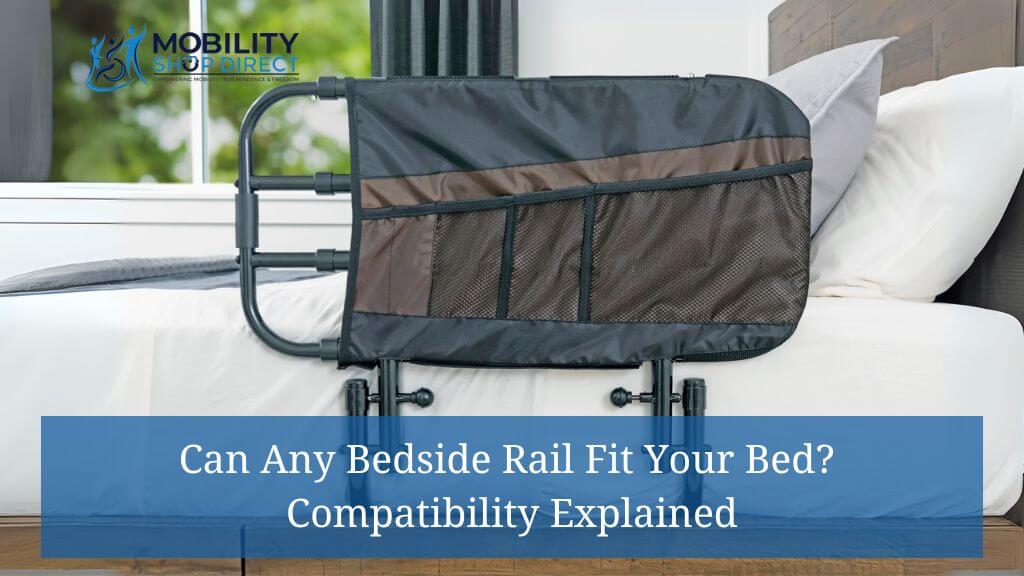Have you ever tried installing a bedside rail only to find that it doesn’t fit your bed properly? It’s frustrating, and more importantly, it can be unsafe. The truth is, picking the right bedside rail takes more than just grabbing a product labeled “universal.” It depends on your bed frame, mattress type, and how the rail is installed. Miss those details, and you could end up with a poor fit, or worse, a safety risk.
Whether you're helping someone else or setting up your own space, finding the right rail is about safety and daily function. This guide walks through the key points, from how different rails work with adjustable beds and mattress types to what to check before buying. After reading, you’ll have a clearer path to choosing the best option for your needs.
Let’s break down how bedside rail compatibility really works and what to look out for.
Table of Contents
- Understanding Bedside Rails: Definition and Purpose
- Key Compatibility Factors for Bedside Rails
- Universal vs. Specific Bedside Rails
- What Are Universal Bed Rails?
- Advantages of Bed-Specific Rails
- Comparing Universal and Bed-Specific Models
- Safety Considerations Before Buying
- How to Measure Bed Rail Compatibility
- Installation Guidelines for Bedside Rails
- Why Proper Installation is Crucial
- Step-by-Step Installation Tips
- Troubleshooting Installation Problems
- Choosing the Right Bedside Rail for Your Needs
- Matching Bedside Rails to User Requirements
- Considering Use Cases for Specific Rails
- Balancing Safety, Functionality, and Price
- FAQs About Bedside Rails
- What Type of Bed Rail Is Best for the Elderly?
- Are Bed Rails Compatible with Adjustable Beds?
- How to Choose Bed Rails for Memory Foam Mattresses?
- What's the Difference Between Bed Rails and Side Rails?
- Key Takeaways
- Conclusion
Understanding Bedside Rails: Definition and Purpose
What Are Bedside Rails?
Bedside rails are support devices that help users stay safe in bed. They reduce the risk of falls and offer a stable surface to grip when getting in or out of bed.
They’re common in hospitals, but just as useful at home, especially for older adults, people with disabilities, or anyone recovering from surgery. Some models also double as grab bars or assistive handles.
Types of Bedside Rails
There’s more than one kind of bedside rail. Here are the main types:
- Fixed vs. Adjustable: Fixed rails stay in place. Adjustable ones can move or fold depending on what the user needs.
- Full-Length vs. Half-Length: Full-length rails run along most of the bed and help prevent falls. Half-length rails are smaller and make getting in and out easier.
- Specialty Rails: These are made for unique setups like hospital beds or bariatric frames.
Choosing the right type depends on whether you care more about fall prevention, flexibility, or ease of use.
Key Compatibility Factors for Bedside Rails
Bed Frame Compatibility
The rail needs to match your bed frame. Standard frames like box springs usually fit most rails. But if you have an adjustable bed, you’ll need a rail made to move with it. The wrong combo can make the rail unstable.
Not sure what type you need? This article on bedside rail compatibility breaks it down clearly.
Mattress-Specific Fit
Mattress thickness and firmness also affect rail fit. Soft options like memory foam can compress under pressure and shift the rail. You’ll want to double-check the specs, especially with non-standard sizes or extra-thick mattresses.
Universal vs. Specific Bedside Rails
What Are Universal Bed Rails?
These rails claim to work on a wide range of beds. They’re adjustable and flexible, great if you're planning to change beds down the line. But they may not be as snug or stable on unusual bed frames.
For more on choosing adjustable rails safely, check out this guide on adjustable bedside rails for adults.
Advantages of Bed-Specific Rails
These are built for a particular kind of bed, like hospital beds or adjustable frames. You give up some flexibility but gain peace of mind knowing the rail fits exactly as it should.
Comparing Universal and Bed-Specific Models
If you want long-term safety, a bed-specific model is probably your best bet. Universal rails offer flexibility, but not always the best fit.
This comparison of bedside rail types goes into more detail on pros and cons.
Safety Considerations Before Buying
Do Bedside Rails Meet Safety Standards?
Only buy rails that follow safety standards. These rules help prevent sharp edges, unsafe gaps, or loose parts. If a rail doesn’t have a certification or clear testing info, skip it.
Are Bed Rails Safe for All Bed Types?
No, they’re not always safe across all beds. For example, some hospital beds need specific rails to match their shape and movement. Always match the rail to your bed type.
This article on bedside rail safety and installation offers a good checklist for what to look out for.
How to Measure Bed Rail Compatibility
Steps to Check Bed Frame Dimensions
Measure the width and height of your bed frame. Look for any built-in attachment points. If your frame is adjustable, be extra careful with sizing.
Mattress-Specific Measurements
Measure your mattress thickness and check edge firmness. Softer or non-standard mattresses often need deeper clamps or adjustable rails for a secure grip.
Installation Guidelines for Bedside Rails
Why Proper Installation is Crucial
A rail that isn’t installed right can be more dangerous than helpful. Loose clamps or bad positioning can lead to falls or injury. Take time to get it right.
Step-by-Step Installation Tips
- Follow the included instructions. Don’t wing it.
- Gather your tools before you start.
- Check and recheck all clamps and screws.
Troubleshooting Installation Problems
If the rail feels loose or wobbly, double-check the manual. Still not working? Contact support or consider switching to a more compatible model.
Choosing the Right Bedside Rail for Your Needs
Matching Bedside Rails to User Requirements
Pick based on who will use it. Older adults often need cushioned grips and strong support. Kids might want something smaller and easier to manage.
Considering Use Cases for Specific Rails
If it's just for a few weeks, go with something lightweight and easy to remove. For daily long-term use, you’ll want something fixed and durable.
Balancing Safety, Functionality, and Price
It’s worth paying for quality here. Better rails last longer and reduce the risk of accidents.
FAQs About Bedside Rails
What Type of Bed Rail Is Best for the Elderly?
Go for a half-length model with padded grips and sturdy design. It makes getting in and out of bed easier and feels less restrictive.
Are Bed Rails Compatible with Adjustable Beds?
Yes, but only if they’re made for that type. Otherwise, they might interfere with how the bed moves.
How to Choose Bed Rails for Memory Foam Mattresses?
Look for deeper clamps and adjustable settings. Memory foam compresses more than standard mattresses, which can loosen the rail.
What's the Difference Between Bed Rails and Side Rails?
Bed rails are add-ons. Side rails are built into the bed itself. Bed rails offer more flexibility across different setups.
Key Takeaways
- Make sure your rail fits your specific bed and mattress type.
- Universal rails work for most beds but may not be the most stable option.
- Check for proper safety testing before you buy.
- Follow installation instructions closely to avoid hazards.
Conclusion
Getting the right bedside rail isn’t just about convenience, it’s about safety and support. Know your bed, take a close look at the specs, and don’t rush the install. Whether it’s for recovery, aging in place, or everyday help, the right rail can make a big difference. Take your time, ask questions, and choose what fits both the bed and the person using it.
You can find solid options in this bedside rails collection without breaking the bank.



